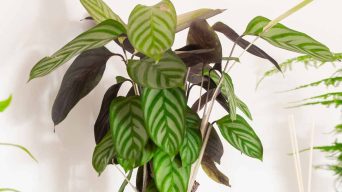Key Takeaways
- Overwatering and underwatering are common reasons why ZZ plant leaves turn brown. It’s crucial to strike the right balance when providing water for your Zamioculcas zamiifolia to prevent root rot and drought stress.
- Low humidity levels can significantly affect the health of your ZZ Plant, leading to brown and crispy leaf tips. To remedy this issue, consider using a humidifier or placing a tray filled with pebbles and water beneath your pot.
- Pests or disease infestations can cause ZZ plant leaves to turn brown. Regularly inspect your plant for signs of pests or diseases like spider mites, whiteflies, or bacterial leaf spot; isolate affected plants immediately; use an insecticidal soap/neem oil/fungicide according to package directions if necessary.
Are your once vibrant ZZ Plant leaves turning brown, leaving you puzzled and concerned?
Fear not, as this common issue among plant owners can often be resolved with the proper care and attention.
Here we’ll uncover the reasons behind browning ZZ Plant leaves – such as overwatering, underwatering, low humidity levels, or even pesky pests – and provide expert solutions to help your Zamioculcas zamiifolia thrive again.
Reasons Why ZZ Plant Leaves Can Turn Brown
The leaves of ZZ Plants can become brown for several reasons, including too much or too little water, low humidity, too much sunlight, and infestation by pests or diseases.
Overwatering Or Underwatering
Overwatering and underwatering are two common reasons why ZZ plant leaves turn brown.
As a plant owner, it’s crucial to strike the right balance when providing water for your Zamioculcas zamiifolia, also known as the emerald palm or Zanzibar gem.
Overwatering can lead to root rot, which prevents essential nutrients from being absorbed effectively by the roots.
On the other hand, underwatering causes drought stress because these plants store water in their rhizomes.
When they don’t receive enough water, they draw upon their stored reserves, leading to brown leaves and dehydrated foliage.
To prevent either problem, allow the top inch of soil in your pot to dry before watering again.
Low Humidity Levels
Low humidity levels in your home can significantly affect the health of your ZZ Plant, leading to brown and crispy leaf tips.
The ideal range for a thriving ZZ Plant is between 40-60% humidity, as these plants are native to tropical environments with consistent moisture in the air.
To remedy this issue and boost your indoor space’s moisture levels for healthier plants, consider placing a humidity tray filled with water and pebbles under your ZZ Plant pot or using a room humidifier near your plant.
Regularly misting leaves with distilled water will add some much-needed moisture to their surroundings while ensuring they stay clean from accumulated dust.
Exposure To Direct Sunlight
Exposure to direct sunlight can be detrimental to the health of your ZZ plant, causing the leaves to turn brown.
Although these plants thrive in bright indirect light, they are not well-suited for full sun exposure.
For instance, imagine placing your Zanzibar gem next to a south-facing window with no shades or curtains.
The intense sunlight will likely cause leaf damage and browning over time.
To prevent this common issue among houseplants, find a location that provides ample filtered light or use sheer curtains if necessary.
Pest Or Disease Infestations
Pests or disease infestations can also cause ZZ plant leaves to turn brown.
Common pests that attack ZZ plants include spider mites and whiteflies, which leave yellow spots on the leaves before turning them brown.
To treat pest or disease infestations, isolate the affected plant from other houseplants immediately to prevent further contamination.
Use an insecticidal soap or neem oil to control pests like spider mites and whiteflies.
It’s important to regularly inspect your ZZ plant for signs of pests or diseases.
How To Identify The Cause Of Brown ZZ Plant Leaves
If you notice brown leaves on your ZZ plant, thoroughly inspect the plant and its environment.
Check the moisture and drainage of the soil, measure humidity levels and light exposure, and look out for any pests or diseases. Read on to find out more about the steps you can take.
Inspect The Plant And Surrounding Environment
Inspecting the plant and its surrounding environment is important to identify the cause of brown ZZ plant leaves.
Here are the steps to follow:
- Look closely at the affected leaves and check for any spots or discoloration.
- Examine the soil moisture and drainage by inserting your finger into the top inch of the soil. If it feels dry, watering is needed; if it feels moist or waterlogged, overwatering might be an issue.
- Measure humidity levels and light exposure. ZZ plants thrive in environments with moderate humidity, around 40-60%, and bright indirect sunlight.
- Check for signs of pests or disease infestations, such as spider mites, whiteflies, or bacterial leaf spot. Look for visible insects or damaged areas on the leaves.
- Note any recent changes in location, temperature, or watering schedule that may have caused stress to the plant.
By following these steps, you can effectively diagnose any issues affecting your ZZ plant’s health and take appropriate actions to address them.
Check Soil Moisture And Drainage
One crucial factor that may contribute to ZZ plant leaves turning brown is improper soil moisture and drainage.
The ZZ plant requires well-draining soil, which means that excess water should be able to flow out of the pot easily.
Overwatering or underwatering can cause drainage issues, leading to root rot and browned leaves.
To check for proper soil moisture levels, stick your finger about an inch into the soil – if it feels dry at this depth, it’s time to water your plant.
However, if the top inch of soil feels moist or damp, wait a few more days before watering again.
Sometimes, tap water containing chlorine or minerals (such as fluoride) can also harm your plants over time.
Measure Humidity Levels And Light Exposure
One of the key factors in identifying the cause of brown ZZ plant leaves is measuring humidity levels and light exposure.
ZZ plants thrive in environments with moderate humidity, ideally between 40-60%.
You can use a hygrometer or a simple moisture meter probe to measure humidity levels to test the soil’s moisture content.
If your ZZ plant is not getting enough light, it may also exhibit brown leaves.
While direct sunlight can burn ZZ plant leaves, they need bright indirect light to grow optimally.
To maintain optimal conditions for your ZZ plant and prevent brown leaves caused by low humidity or insufficient lighting, consider using a humidifier or placing a tray filled with pebbles and water beneath your pot to increase moisture levels in the air around it.
Additionally, if you notice that your ZZ plants are receiving too much sunlight (directly or indirectly), try moving them further away from windows or into an area where they receive dappled shade instead.
Identify Pests Or Diseases
One of the reasons ZZ plant leaves can turn brown is due to pest or disease infestations.
ZZ plants’ common pests include spider mites, mealybugs, and whiteflies.
These pests suck sap from the leaves, causing them to wilt and turn yellow or brown.
Bacterial leaf spot is another potential issue that affects ZZ plants.
Inspect the plant and its surrounding environment regularly to identify pest or disease problems on your ZZ plant.
Check for any signs of infestation, such as webs or discoloration on the leaves, and monitor soil moisture levels closely since overwatering can increase the risk of root rot and other issues.
How To Fix Brown ZZ Plant Leaves
To fix brown ZZ plant leaves, move the plant to a location with better light or humidity levels, treat for pests or diseases if necessary, and carefully trim any brown leaves.
Move The Plant To A Different Location
If you’ve identified that your ZZ plant’s brown leaves are due to exposure to direct sunlight or low humidity levels, moving the plant to a different location may be the solution.
ZZ plants thrive in bright, indirect light and prefer temperatures between 65-85 degrees Fahrenheit.
Consider finding a spot near an east or north-facing window where it can receive plenty of natural light without being directly in the sun’s path.
In addition to light, humidity is crucial for healthy ZZ plant growth. If you live in a dry climate or have central heating or air conditioning, consider placing a humidifier nearby to give your plant the moisture it needs.
Alternatively, you could place your ZZ plant on top of a tray filled with pebbles and water, ensuring that its roots don’t come into contact with standing water.
Treat For Pests Or Diseases
Pests and diseases can also cause ZZ plant leaves to turn brown.
It is important to promptly identify and address these issues to prevent further damage to your plant.
Here are some steps you can take:
- Inspect the plant – Look for signs of pests like spider mites, mealybugs, and whiteflies or symptoms of common diseases like bacterial leaf spot or root rot.
- Use a natural treatment – Consider using organic methods like Neem oil, insecticidal soap, or a homemade mixture of water and dish soap to control pests.
- Apply a fungicide – If you suspect your plant has a disease, use a suitable fungicide according to the instructions on the label.
- Replanting – If your ZZ plant continues to suffer from pest or disease infestations despite treatments, replanting the entire plant in fresh potting soil may be necessary.
Remember that prevention is key regarding pests and diseases in plants.
Regularly inspecting your ZZ plant for signs of infestations and maintaining healthy conditions through proper watering and lighting can help reduce the risk of problems.
Trim Brown Leaves With Care
If your ZZ Plant leaves have turned brown, it is essential to trim them before the discoloration spreads and affects other foliage.
However, doing this task is crucial as ZZ Plants are delicate and can easily get damaged during pruning.
You should use a sharp pair of scissors or pruning shears to cut off only the affected parts of the leaf while leaving the rest intact.
Additionally, avoid using dull tools as they can create ragged cuts that will leave more room for disease-causing organisms to enter the wound.
Tips To Prevent ZZ Plant Leaves From Turning Brown
To take good care of your plant, adjust its watering schedule to prevent over or underwatering.
You can also increase humidity levels by placing a humidifier nearby and providing proper lighting with bright indirect light.
Don’t forget to clean the leaves from dust and debris regularly. Lastly, fertilize sparingly every 2-3 months with a balanced fertilizer to keep your plant healthy.
Adjust Watering Schedule
Proper watering is crucial to keep ZZ plant leaves from turning brown.
Over or underwatering can cause stress and lead to irreversible damage.
It’s important to water the plant when the top 2-3 inches of soil feel dry, about once a week during warmer months and every two weeks during colder months.
If you’re unsure how much water your ZZ plant needs, use a moisture meter or check the weight of the pot – if it feels light, it may be time for watering.
Also, don’t let standing water in the pot, which could suffocate roots and cause mold growth.
Increase Humidity Levels
ZZ plants are native to East Africa and thrive in humid environments.
Therefore, one of the reasons why ZZ plant leaves turn brown is due to low humidity levels in our homes.
Increasing the moisture content in the air around it is essential to ensure that your plant stays healthy and vibrant.
This can be achieved by using a humidifier or placing a tray with water near your ZZ plant.
It’s important to note that too much moisture can lead to other issues, such as fungal infections and root rot.
It’s best to keep humidity levels between 40-60%, depending on your location and season.
Provide Proper Lighting
Proper lighting is crucial to ZZ plant health and can greatly impact leaf color and growth. ZZ plants prefer bright, indirect light but can also tolerate low-light conditions.
Too much direct sunlight can cause brown spots or sunburn on leaves, while too little light may result in slow growth or yellowing foliage.
If you notice brown spots or yellowing leaves on your ZZ plant, it could be a sign that it’s not getting enough light.
Move the plant closer to a window with filtered sunlight or invest in a grow light if needed.
Similarly, if you notice new shoots stretching towards the closest source of natural light, this could indicate that the current location is not providing adequate lighting.
Regularly Clean The Leaves
To prevent ZZ plant leaves from turning brown, it is essential to keep the foliage clean.
Dust and debris can clog the pores on the leaf surface, inhibiting photosynthesis and leading to discoloration.
To clean your ZZ plant’s leaves, use a damp cloth or sponge and gently wipe both sides of each leaf.
Cleaning your ZZ plant’s leaves enhances its appearance and improves its overall health by removing harmful particles that can impede growth and development.
Final Thoughts
ZZ Plants are tough and drought-tolerant houseplants.
However, they can develop brown leaves for various reasons, such as overwatering, underwatering, low humidity levels, or exposure to direct sunlight.
It’s essential to identify the cause of the problem and take corrective action quickly before it’s too late.
By following our tips on fixing and preventing ZZ Plant leaves from turning brown, you can help your plant thrive and maintain its greenery all year round.
Remember that every plant is unique and requires different care needs based on its growth cycle and environment.







